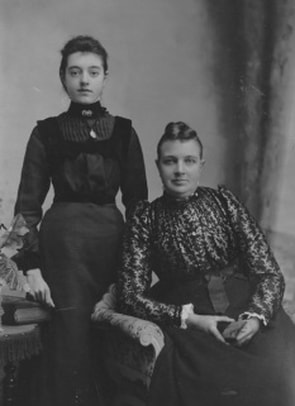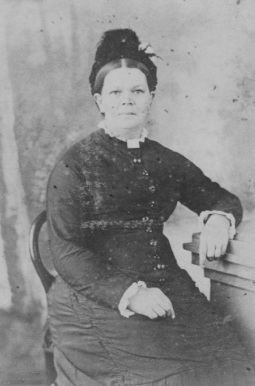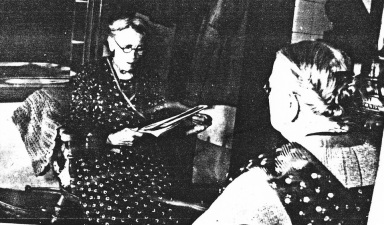|
Leah Priscilla Oatley, 1856 - 1947:
Girl from the Workhouse Alan Payne, July 2014 Based on the research of the Oatley family, particularly Ken Oatley and Mrs Peggy E Martin All photos courtesy of Ken Oatley. We should beware of judging people too quickly. Some people today might have preconceived ideas about an unmarried woman with five children living on social security. But this story goes back 150 years and is a tale of triumph over adversity. Right: Leah Priscilla and daughter Elsie Kathleen, 1908 |
Early Life
Leah Priscilla Oatley was born in Box in March 1856, the ninth of twelve children of James Oatley (1816 - 1882) and his first wife, Sarah Poulson (1817 - 1875) who came from Atworth. James was variously described as mason, stone miner, Quarrymaster and baker. He appears to have worked hard and he owned a dwelling house at Quarry Hill but the size of the family must have been a huge burden.
We might imagine that Leah Priscilla was often overlooked in the family. We know that she was illiterate and could only make her mark. Her situation worsened, particularly when James married again about 1876 and had three more children with his second wife, Rebecca Beer Bond (1840 - 1909).
In 1878 Leah Priscilla had given birth to a child, Albert Edward Oatley, (1878 - 1909) whilst living at 5 Gas Lane, Cirencester.
The father's name is given as John Oatley, mason's labourer. It has not been possible to absolutely define who the father was; the only identified John Oatley was Leah's grandfather, a weaver, but possibly a false name had been given.
Raising a Family
Leah Priscilla moved back to Box and more children followed: Percy George Oatley (b 1880), Sydney Wallace Wait Oatley
(b 1882), Oliver Alic Oatley (b 1884) and Elsie (sometimes called Elizabeth) Kathleen Oatley (b 1887). No father's name was given on the birth certificates for any of these children but the father of Sydney could have been Wallace Waite (b 1859).
Leah Priscilla Oatley was born in Box in March 1856, the ninth of twelve children of James Oatley (1816 - 1882) and his first wife, Sarah Poulson (1817 - 1875) who came from Atworth. James was variously described as mason, stone miner, Quarrymaster and baker. He appears to have worked hard and he owned a dwelling house at Quarry Hill but the size of the family must have been a huge burden.
We might imagine that Leah Priscilla was often overlooked in the family. We know that she was illiterate and could only make her mark. Her situation worsened, particularly when James married again about 1876 and had three more children with his second wife, Rebecca Beer Bond (1840 - 1909).
In 1878 Leah Priscilla had given birth to a child, Albert Edward Oatley, (1878 - 1909) whilst living at 5 Gas Lane, Cirencester.
The father's name is given as John Oatley, mason's labourer. It has not been possible to absolutely define who the father was; the only identified John Oatley was Leah's grandfather, a weaver, but possibly a false name had been given.
Raising a Family
Leah Priscilla moved back to Box and more children followed: Percy George Oatley (b 1880), Sydney Wallace Wait Oatley
(b 1882), Oliver Alic Oatley (b 1884) and Elsie (sometimes called Elizabeth) Kathleen Oatley (b 1887). No father's name was given on the birth certificates for any of these children but the father of Sydney could have been Wallace Waite (b 1859).
|
Without a husband's income, Leah Priscilla would have struggled to survive. In 1881 she lived with her sister, Sarah, and brother-in-law, Henry Chandler, a baker and grocer, in Box. Her first two children were boarding with Esther and James Bull, aged 50, a farm labourer, at Folly Farm, Box.
She would have survived as she could and she seems to have had her father's support. When James died in 1882, he left £10 to each of the three youngest of Sarah's children and a feather bed to Leah Priscilla and her younger sister. We don't know Leah's reason for her illegitimate children. It might have been lack of morality but James' gift to her might be an indication that her circumstances were accepted by her father. Perhaps he felt sorry for her in her circumstances. Perhaps there was some element of family guilt. The bulk of James' estate went to his second family, particularly the eldest of those children, Charles William Bond Oatley. |
Into the Workhouse, 1887
By 1887, circumstances had clearly deteriorated for Leah Priscilla and she is recorded as living in the Chippenham Union Workhouse (now St Andrews Hospital) as one of the indoor poor. The old Box Poorhouse, under the paternal care of the local parish Overseers, had closed fifty years before and conditions were tough in the Chippenham Union workhouse.
There is a reference indicating that Leah Priscilla's children had been born in workhouses in Chippenham and Cirencester but this appears to be incorrect, although it is possible that her family were variously admitted and released.
But in 1887 all five of her children, aged between 9 years and the baby, Elsie Kathleen, just a few months old, had been admitted into the workhouse. We might imagine that all help had deserted the family, along with her family and friends, and their survival depended on submitting themselves to the shameful workhouse, to which only the destitute went.
Marriage in 1892
Finally, at the age of 37, in October 1892, Leah Priscilla married Alfred Smith, a clerk, from Lowden, Chippenham. They lived in Parliament Street, Chippenham. We hope that her life stabilised at this point and there is great credit to Alfred for taking on such a family commitment. We can see from the photos in these articles that Leah Priscilla was very close to her only daughter and youngest child, Elsie Kathleen. In 1908 the daughter married James Edward Milsom, a Primitive Methodist who worked for a quarry company for most of his life.
We might imagine that Leah Priscilla had brought up her children to be god-fearing despite their poverty and this marriage began a new chapter in the family story. Elsie Kathleen and James Milsom moved down to Shepton Mallet, Somerset at some time, possibly after the Great War. Leah Priscilla had moved into their home by the mid 1930s.
She is remembered by her grandchild, Peggy Martin, as a person of great fun who chased her round the kitchen table. She was a fine needlewoman and the maker of most beautiful crochet. She died, aged 92, in 1947 whilst living with Elsie and James after a long period of being confined to her room with bad legs.
By 1887, circumstances had clearly deteriorated for Leah Priscilla and she is recorded as living in the Chippenham Union Workhouse (now St Andrews Hospital) as one of the indoor poor. The old Box Poorhouse, under the paternal care of the local parish Overseers, had closed fifty years before and conditions were tough in the Chippenham Union workhouse.
There is a reference indicating that Leah Priscilla's children had been born in workhouses in Chippenham and Cirencester but this appears to be incorrect, although it is possible that her family were variously admitted and released.
But in 1887 all five of her children, aged between 9 years and the baby, Elsie Kathleen, just a few months old, had been admitted into the workhouse. We might imagine that all help had deserted the family, along with her family and friends, and their survival depended on submitting themselves to the shameful workhouse, to which only the destitute went.
Marriage in 1892
Finally, at the age of 37, in October 1892, Leah Priscilla married Alfred Smith, a clerk, from Lowden, Chippenham. They lived in Parliament Street, Chippenham. We hope that her life stabilised at this point and there is great credit to Alfred for taking on such a family commitment. We can see from the photos in these articles that Leah Priscilla was very close to her only daughter and youngest child, Elsie Kathleen. In 1908 the daughter married James Edward Milsom, a Primitive Methodist who worked for a quarry company for most of his life.
We might imagine that Leah Priscilla had brought up her children to be god-fearing despite their poverty and this marriage began a new chapter in the family story. Elsie Kathleen and James Milsom moved down to Shepton Mallet, Somerset at some time, possibly after the Great War. Leah Priscilla had moved into their home by the mid 1930s.
She is remembered by her grandchild, Peggy Martin, as a person of great fun who chased her round the kitchen table. She was a fine needlewoman and the maker of most beautiful crochet. She died, aged 92, in 1947 whilst living with Elsie and James after a long period of being confined to her room with bad legs.
|
Conclusion
So before we rush into making conclusions about people and their lifestyles, perhaps we should remember Leah Priscilla Oatley and her indomitable strength of character. It isn't the status that people are born into that matters; it is how they handle the lot they are dealt with. Right: Leah Priscilla (reading) in later years |


